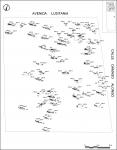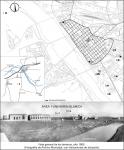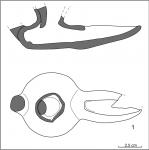Summary (English)
The stratigraphy turned out to be of little complexity in the greater part of the site, formed by three levels: one of topsoil, another of loamy brown soil and finally, one of a uniform layer of clay which conformed with the gradients of the rocky ground, determining its depth. The excavation is characterized by the lack of structures, with the exception of a well; however the archaeological works provided valuable data for an Islamic funeral area and the exploitation of the header of the site as a clayey ground, with various types of waste from Roman potteries.
In the greater part of the site the stratigraphy ended with a level of orange clays of varying depth, from 40 centimeters to 1 meter, until it reach the rock, where several paleolithic artifacts were collected similar to the ones found in a neighboring intervention (8035). However, in the northern area, under the humus, this level of clay soil did not appear, but instead sand depositions of Roman pottery, ashes and rubbles were found directly placed on the rock. This surface “free” from clay, which extends over the northern end of the site, owes this to its exploitation as a quarry used by the pottery makers and roman manufacturers of roofing tiles.
These strata were cut by 57 tombs of the Islamic rite, in simple narrow and superficial graves, oriented southwest-northeast and with the deceased placed in right lateral decubitus position. No material of the Islamic period was found, except for one oil lamp with a lenticular shape and a developed bunghole; although it did not appear within one of the graves, it is the only illustrative item to deduce the dating of the funeral area.
The material inside the waste of the pottery production corresponds to 415 shreds, 97 of them are rims. In the lot there are pieces with cracks caused by the firing, others show signs of deformities and a few are burnt, these faults confirm their belonging to a workshop. Two different hands are recognized based on the different ways in which the lids are made. It is a limited series of common pottery forms corresponding to cooking pots, pots to prepare or serve foods, auxiliary cookware, tableware, containers for storage and preservation and also loom weights.
After the marsh was abandoned in the Roman period there is no other indication of its occupation until its conversion into a maqbara during the Middle Ages. The identified graves are 57 and shape the periphery of a burial site whose core is located to the north and it was expanded until this point. Until the present these are the Islamic tombs documented furthest away from the city, with a location which is associated with a path which went parallel with the river and lead to (or from) one of the gates of the Alcazaba to the main road to Córdoba. All of them face the south-east and a spontaneous spatial organization can be observed. However, there are rows with interval spaces, very ample, which facilitate the crossings of gravediggers and visitors, although these “fluctuating” lines neither follow a rigorous route nor an ordered consecutive development.
The arguments for the dating are based on the typology of the oil lamp found in the excavation that follows the caliphal models, the direction of the face towards the south-east, the format of the “Arabian” curved tile, fully evolved, which covers a few child tombs and the superficiality and narrowness of the graves in compliance with the malikite doctrine. On the other hand, there are historical facts pointing to the caliphal
period.Due to the lack of structures and weighing the patrimonial value of the tombstones and the muddy ground, the Comisión del Consorcio decided to authorize the slope across the entire site to allow the construction of underground garages, as was considered by the presented architectonic project.
(translation by Esther Casares Carmona)
- Miguel Alba Calzado
Director
- Miguel Alba Calzado (Consorcio Ciudad Monumental de Mérida)
Team
- Miguel Alba
- Valentín Mateos y Joaquín Suárez
- Conrado García (documentalista de la parte contemporánea)
- Javier Pacheco
- Mauricio Conde y Aniceto Palencia (empresa Nova Romana)
Research Body
- Consorcio Ciudad Monumental de Mérida
Funding Body
- Nova Romana S.L.






![Download [PDF]](/excavation/skins/fasti/images/results/download_sml.png)







